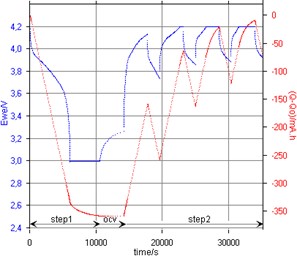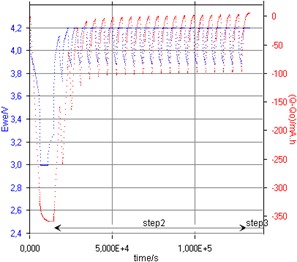Galvanostatic Cycling with Potential limitation 4: Low Earth Orbit (LEO) battery satellite protocol (GITT#2) Battery – Application Note 3
Latest updated: November 28, 2023Abstract
In most battery testing using CCCV (CC-CV) charging schedule, the first step is limited in cell voltage, and the second step is either limited in time, drop of current or total charge passed. But there are certain applications that have a very distinct time limit for the battery to charge, like in aerospace in Low Earth Orbit, or geostationary satellite applications. This GCPL-4 technique available with any BioLogic potentiostat-galvanostat-ZRA or battery cycler, performs CCCV charge with a the time limit pertaining to the entire charge (or discharge) sequence.
Introduction
The aim of this paper is to describe an application for the GCPL-4 protocol in the field of battery testing. This protocol is available with EC-lab software and can be used with all our instruments.
This galvanostatic cycling protocol has a different timing from the previous GCPL protocol, in that the total duration of every sequence is defined, independently, from the fact that at a given time during the step, the maximum potential can be reached and the instrument turns from the initial galvanostatic mode to a constant potential one.
For comparison, in GCPL and GCPL-3 the initial galvanostatic mode run for a maximum time (t1) and if a potential limit (WE-RE in GCPL, WE-CE in GCPL-3) is reached in that time, the duration of the constant potential mode that follows is either set to a given time (tM) or limited by the condition for the redox current to be lower than a given value. In GCPL-2, if a potential limit is reached on the galvanostatic sequence, the system switches to the next step without any constant potential sequence.
EXPERIMENTAL PART
After a full charge (not shown here) the battery was first discharged down to 3.0 V with a constant potential period until the discharge current (Fig. 1) was less than 5 mA (Step 1, for about 3 h). This was carried out in order to measure the effective capacity of this aged battery. One hour open circuit period was then set, to follow the open circuit voltage (OCV) of the discharged battery.

Figure 1: Ewe and (Q-Q0) evolution versus time at the beginning of the experiment.
Then the “LEO” cycling was started (Steps 2 and 3, Fig. 2) for a total of 21 cycles. No rest periods were set in this cycling, in agreement with the fact that in the real application the battery turns from charge to discharge as soon as the satellite goes from sunlight to darkness.

Figure 2: Ewe and (Q-Q0) evolution versus time for all the experiment.
A final charge period with a constant potential duration fixed by a charge current lower than 5 mA was performed, in order to check how much the battery could be charged in this condition, compared to the standard one during the “LEO” periods. A long final OCV was set to determine the equilibrium potential of the charged battery.
RESULTS AND DISCUSSION
Fig. 1 shows the time dependence of the potential (Ewe) and of the total charge (Q-Q0) from the beginning of the experiment. The initial deep discharge (step 1, down to 3 V) appears to take about 3 h and the effective battery capacity is close to 360 mA·h. Thus, the galvanostatic charge/discharge conditions (200 mA) are slightly larger than a C/2 regime, and the 5 mA limit current in the deep initial discharge and final charge corresponds to a C/72 regime, i.e. close to reaching total discharge/charge. After the 1 h rest period the OCV is 3.27 V, but has not reached equilibrium yet.
Then the LEO cycling starts. On the first charge (200 mA for 1 h, with 4.2 V limit) the potential limit was not reached, due to the fact that it started from a deeply discharged state. In the following discharge (-200 mA for 0.5 h) the potential decayed from 4.08 to 3.74 V under current.
Then on the second charge/discharge cycle the 4.2 V charge limit was reached for a short time, and the potential decayed from 4.16 to 3.86 V.
On a longer time scale (Fig. 2) one can see that the charge/discharge of the battery is close to its dynamic equilibrium on the fourth cycle, the discharge occurring in the 4.17 V – 3.89 V window.
The slight increase of the total charge with cycling corresponds to the fact that the battery approaches its maximum charge, also illustrated by the final charge, in which the constant potential period was not limited by the total duration of the charge period, but by a final 5 mA charge current. After a 24 h rest period the OCV appears to be 4.16 V, which corresponds to the equilibrated fully charged battery.
CONCLUSION
In this application note, we have shown that the specificities of the GCPL-4 technique where the total duration of a sequence is fixed regardless of whether the limits during CC and CV steps are reached or not.
An application example is shown, the Low Earth Orbit battery satellite protocol, where the battery will enter charge and discharge cycles periodically.